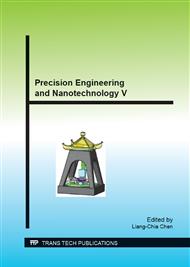[1]
H.K. Tonshoff, E. Brinkomeier, Determination of the mechanical and thermal influences on machined surface by microhardness and residual stress analysis, Annales of CIRP 29 (2) (1986) 519–532.
DOI: 10.1016/s0007-8506(16)30145-7
Google Scholar
[2]
M.C. Shaw, J.D. Pigott, L.P. Richardson, Effect of cutting fluid upon chip–tool interface temperature, Transactions of ASME 71 (1951) 45–56.
DOI: 10.1115/1.4016134
Google Scholar
[3]
S. Paul, N.R. Dhar, A.B. Chattopadhyay, Beneficial effects of cryogenic cooling over dry and wet machining on tool wear and surface finish in turning AISI 1060 steel, Proceedings of ICAMT-2000, Malaysia (2000) 209–214.
DOI: 10.1016/s0924-0136(01)00839-1
Google Scholar
[4]
N.R. Dhar , M.W. Islam a, S. Islam , M.A.H. Mithu, The influence of minimum quantity of lubrication (MQL)on cutting temperature, chip and dimensional accuracy in turning AISI-1040 steel, Journal of Materials Processing Technology 171 (2006) 93–99.
DOI: 10.1016/j.jmatprotec.2005.06.047
Google Scholar
[5]
V.N. Gaitondea, S.R. Karnikb, J. Paulo Davimc, Selection of optimal MQL and cutting conditions for enhancing machinability in turning of brass, journal of materials processing technology 204 (2008) 459–464.
DOI: 10.1016/j.jmatprotec.2007.11.193
Google Scholar
[6]
N.R. Dhar , M. Kamruzzaman, Mahiuddin Ahmed, Effect of minimum quantity lubrication (MQL) on tool wear and surface roughness in turning AISI-4340 steel, Journal of Materials Processing Technology 172 (2006) 299–304.
DOI: 10.1016/j.jmatprotec.2005.09.022
Google Scholar
[7]
Y. Kamata, T. Obikawa, High speed MQL finish-turning of Inconel 718 with different coated tools, Journal of Materials Processing Technology 192–193 (2007) 281–286.
DOI: 10.1016/j.jmatprotec.2007.04.052
Google Scholar
[8]
A.R. Moghadassi, S.M. Hosseini, D. Henneke, A. Elkamel, A model of nanofluids effective thermal conductivity based on dimensionless groups, Journal of Thermal Analysis and Calorimetry 96 (1) (2009) 81–84.
DOI: 10.1007/s10973-008-9843-z
Google Scholar
[9]
Y. Hwang, H.S. Park, J.K. Lee, W.H. Jung, Thermal conductivity and lubrication characteristics of nanofluidss, Current Applied Physics, 6 S1 (2006) e67–e71.
DOI: 10.1016/j.cap.2006.01.014
Google Scholar
[10]
B. Shen, A. Shih, and S.C. Tung, Application of nanofluidss in minimum quantity lubrication grinding, Tribology & Lubrication Technology, 51 (2008) 730-737.
DOI: 10.1080/10402000802071277
Google Scholar
[11]
S. Prabhu, B. KVinayagam, Nano surface generation of grinding process using carbon nano tubes, Sadhana , 35, 6 (2010) 747-760.
DOI: 10.1007/s12046-010-0048-3
Google Scholar
[12]
P.H. Lee, T.S. Nam, C.J. Li, S.W. Lee, Experimental study on meso-scale milling process using nanofluids minimum quantity lubrication and compressed chilly air, in: Proceedings of the of International Conference on Mechanical, Industrial, and Manufacturing Technologies, (2010).
DOI: 10.1115/1.859544.paper71
Google Scholar
[13]
Nam, J.S., Lee, P.H., Lee, S.W., Experimental characterization of micro-drilling process using nanofluids minimum quantity lubrication, Inter. J. Mach. Tool Manufacture , 51 (2011) 649-652.
DOI: 10.1016/j.ijmachtools.2011.04.005
Google Scholar
[14]
P. Vamsi Krishna , R.R. Srikant , D. Nageswara Rao, Experimental investigationon the performance of nanoboric acid suspensionsin SAE-40 and coconut oil during turning of AISI1040 steel, International Journal of Machine Tools & Manufacture 50 (2010).
DOI: 10.1016/j.ijmachtools.2010.06.001
Google Scholar
[15]
S. Ijima, C. Brabec, A. Maiti and J.J. Bernholc, Structural flexibility of carbon nanotubes, Chem. Phys 104 (5) (1996) 2089-(2092).
DOI: 10.1063/1.470966
Google Scholar
[16]
A. Krishnan, E. Dujardin, T. W. Ebbesen, P. N. Yianilos, and M. M. J. Treacy, Young's modulus of single-walled nanotubes, Physical Review B, 58 (20) (1998) 14-19.
DOI: 10.1103/physrevb.58.14013
Google Scholar
[17]
F. D. S. Marquis, L. P. F. Chibante, Improving the heat transfer of nanofluidss and nanolubricants with carbon nanotubes, JOM, 57, 12 (2005) 32-43.
DOI: 10.1007/s11837-005-0180-4
Google Scholar
[18]
Xiang-Qi Wang; Arun S. Mujumdar, A review on nanofluids - part I: theoretical and numerical investigations, Braz. J. Chem. Eng. 25, 4 (2008) 613 - 630.
DOI: 10.1590/s0104-66322008000400001
Google Scholar
[19]
B. Munkhbayar, M.J. Nine, S. Hwang, J. Kim, K. Bae, H. Chung, H. Jeong, Effect of grinding speed changes on dispersibility of the treated multi-walled carbon nanotubes in aqueous solution and its thermal characteristics, Chemical Engineering and Processing 61 (2012).
DOI: 10.1016/j.cep.2012.06.013
Google Scholar
[20]
B. Munkhbayar, M.J. Nine, J. Jeoun, M. Bat-Erdene, H. Chung, H. Jeong, Influence of dry and wet ball milling on dispersion characteristics of the multi-walled carbon nanotubes in aqueous solution with and without surfactant, Powder Technology 234 (2013).
DOI: 10.1016/j.powtec.2012.09.045
Google Scholar


